Annotated Bibliography: Elder Abuse in Palliative Care - Coursework
VerifiedAdded on 2020/03/16
|8
|1279
|84
Annotated Bibliography
AI Summary
This annotated bibliography examines elder abuse within the context of palliative care, drawing on several key articles. The bibliography begins by citing Fulmer et al. (2014), which explores mistreatment in the elderly, providing a foundation for understanding the prevalence and forms of abuse. Lachs and Pillemer (2015) are then cited for their identification of various types of elder abuse, including physical, psychological, sexual, neglect, and financial abuse. Brandl and Raymond (2012) are cited for their work on the causes of elder abuse, challenging the notion that caregiver stress is the primary factor. Lachs and Pillemer (2015) are again referenced for their insights into the signs of elder abuse, emphasizing the importance of recognizing these indicators for intervention. Finally, Mariam et al. (2013) are cited for their evaluation of an elder abuse intervention program, highlighting the effectiveness of community-based support and motivational interviewing techniques in helping at-risk elders. The bibliography provides a comprehensive overview of the issue, covering the types, causes, signs, and potential solutions to elder abuse within palliative care settings.
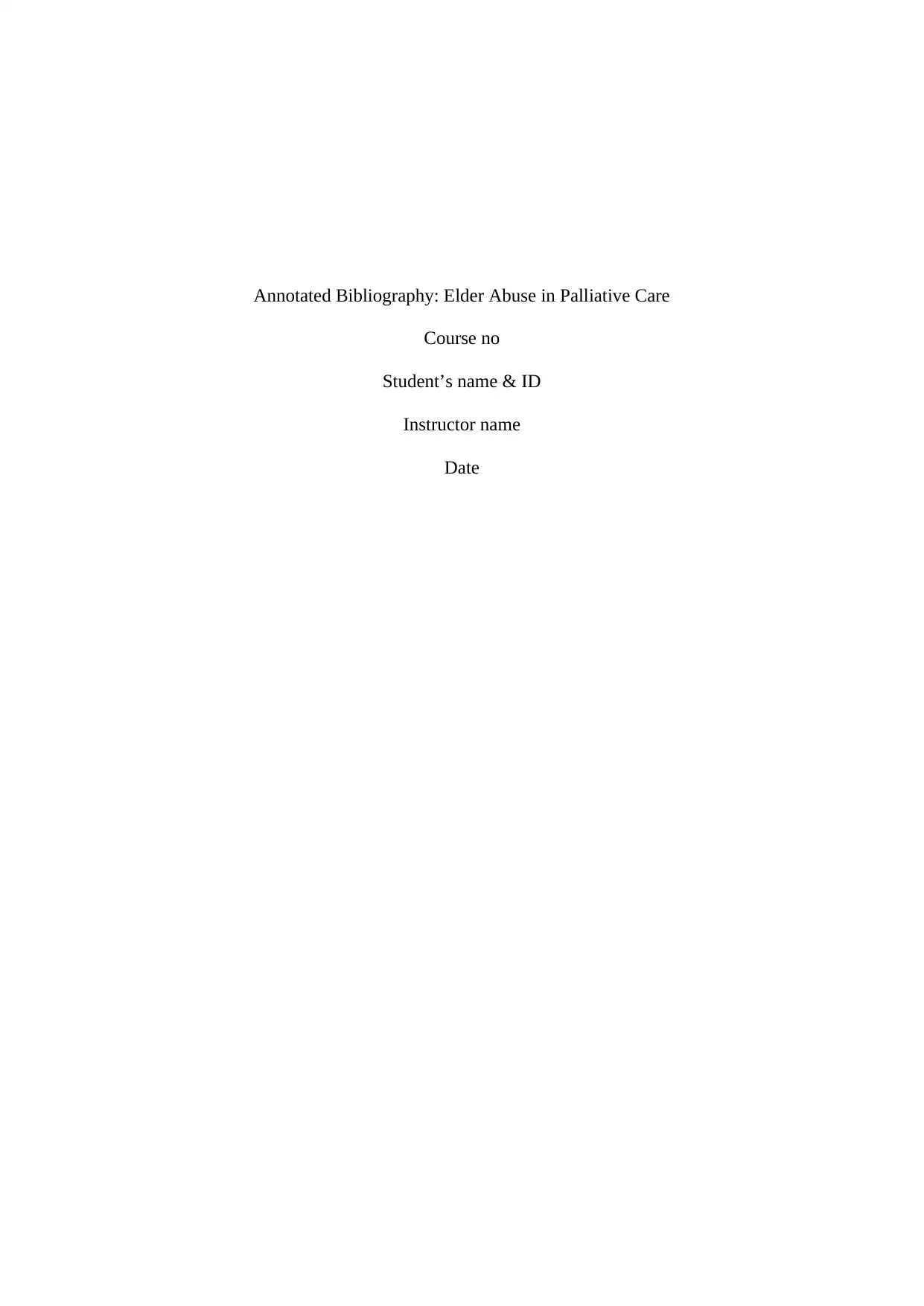
Annotated Bibliography: Elder Abuse in Palliative Care
Course no
Student’s name & ID
Instructor name
Date
Course no
Student’s name & ID
Instructor name
Date
Paraphrase This Document
Need a fresh take? Get an instant paraphrase of this document with our AI Paraphraser
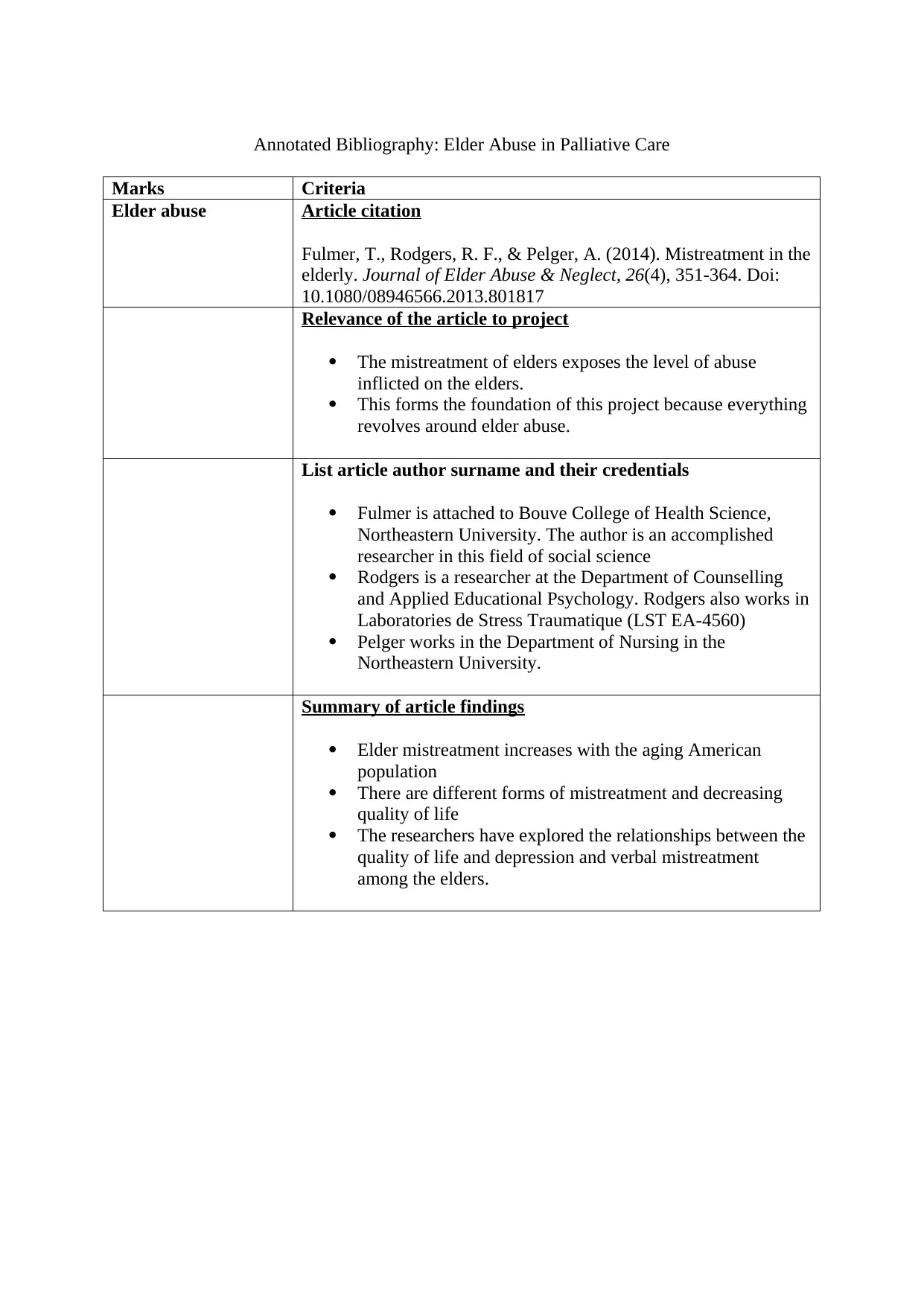
Annotated Bibliography: Elder Abuse in Palliative Care
Marks Criteria
Elder abuse Article citation
Fulmer, T., Rodgers, R. F., & Pelger, A. (2014). Mistreatment in the
elderly. Journal of Elder Abuse & Neglect, 26(4), 351-364. Doi:
10.1080/08946566.2013.801817
Relevance of the article to project
The mistreatment of elders exposes the level of abuse
inflicted on the elders.
This forms the foundation of this project because everything
revolves around elder abuse.
List article author surname and their credentials
Fulmer is attached to Bouve College of Health Science,
Northeastern University. The author is an accomplished
researcher in this field of social science
Rodgers is a researcher at the Department of Counselling
and Applied Educational Psychology. Rodgers also works in
Laboratories de Stress Traumatique (LST EA-4560)
Pelger works in the Department of Nursing in the
Northeastern University.
Summary of article findings
Elder mistreatment increases with the aging American
population
There are different forms of mistreatment and decreasing
quality of life
The researchers have explored the relationships between the
quality of life and depression and verbal mistreatment
among the elders.
Marks Criteria
Elder abuse Article citation
Fulmer, T., Rodgers, R. F., & Pelger, A. (2014). Mistreatment in the
elderly. Journal of Elder Abuse & Neglect, 26(4), 351-364. Doi:
10.1080/08946566.2013.801817
Relevance of the article to project
The mistreatment of elders exposes the level of abuse
inflicted on the elders.
This forms the foundation of this project because everything
revolves around elder abuse.
List article author surname and their credentials
Fulmer is attached to Bouve College of Health Science,
Northeastern University. The author is an accomplished
researcher in this field of social science
Rodgers is a researcher at the Department of Counselling
and Applied Educational Psychology. Rodgers also works in
Laboratories de Stress Traumatique (LST EA-4560)
Pelger works in the Department of Nursing in the
Northeastern University.
Summary of article findings
Elder mistreatment increases with the aging American
population
There are different forms of mistreatment and decreasing
quality of life
The researchers have explored the relationships between the
quality of life and depression and verbal mistreatment
among the elders.
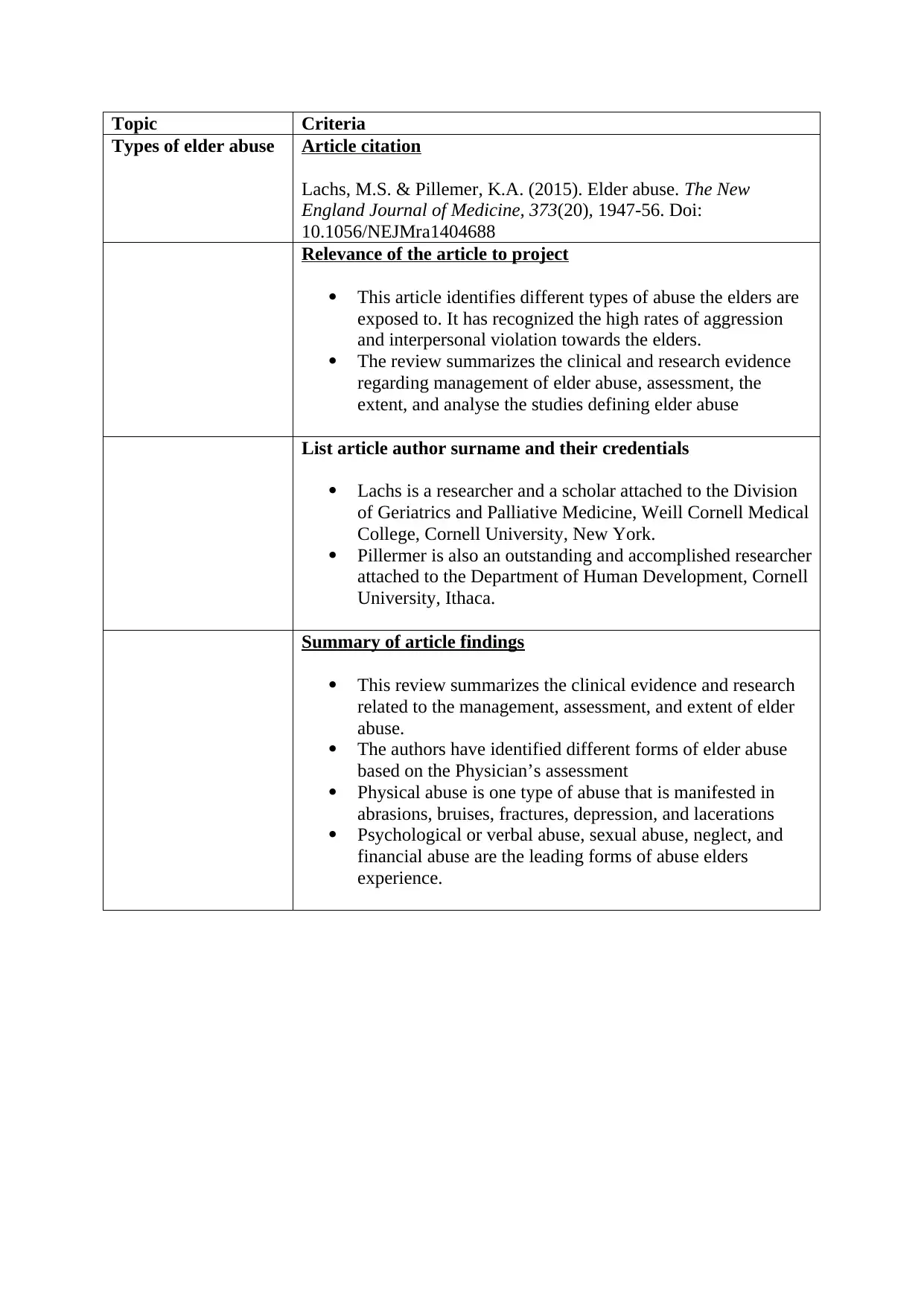
Topic Criteria
Types of elder abuse Article citation
Lachs, M.S. & Pillemer, K.A. (2015). Elder abuse. The New
England Journal of Medicine, 373(20), 1947-56. Doi:
10.1056/NEJMra1404688
Relevance of the article to project
This article identifies different types of abuse the elders are
exposed to. It has recognized the high rates of aggression
and interpersonal violation towards the elders.
The review summarizes the clinical and research evidence
regarding management of elder abuse, assessment, the
extent, and analyse the studies defining elder abuse
List article author surname and their credentials
Lachs is a researcher and a scholar attached to the Division
of Geriatrics and Palliative Medicine, Weill Cornell Medical
College, Cornell University, New York.
Pillermer is also an outstanding and accomplished researcher
attached to the Department of Human Development, Cornell
University, Ithaca.
Summary of article findings
This review summarizes the clinical evidence and research
related to the management, assessment, and extent of elder
abuse.
The authors have identified different forms of elder abuse
based on the Physician’s assessment
Physical abuse is one type of abuse that is manifested in
abrasions, bruises, fractures, depression, and lacerations
Psychological or verbal abuse, sexual abuse, neglect, and
financial abuse are the leading forms of abuse elders
experience.
Types of elder abuse Article citation
Lachs, M.S. & Pillemer, K.A. (2015). Elder abuse. The New
England Journal of Medicine, 373(20), 1947-56. Doi:
10.1056/NEJMra1404688
Relevance of the article to project
This article identifies different types of abuse the elders are
exposed to. It has recognized the high rates of aggression
and interpersonal violation towards the elders.
The review summarizes the clinical and research evidence
regarding management of elder abuse, assessment, the
extent, and analyse the studies defining elder abuse
List article author surname and their credentials
Lachs is a researcher and a scholar attached to the Division
of Geriatrics and Palliative Medicine, Weill Cornell Medical
College, Cornell University, New York.
Pillermer is also an outstanding and accomplished researcher
attached to the Department of Human Development, Cornell
University, Ithaca.
Summary of article findings
This review summarizes the clinical evidence and research
related to the management, assessment, and extent of elder
abuse.
The authors have identified different forms of elder abuse
based on the Physician’s assessment
Physical abuse is one type of abuse that is manifested in
abrasions, bruises, fractures, depression, and lacerations
Psychological or verbal abuse, sexual abuse, neglect, and
financial abuse are the leading forms of abuse elders
experience.
⊘ This is a preview!⊘
Do you want full access?
Subscribe today to unlock all pages.

Trusted by 1+ million students worldwide
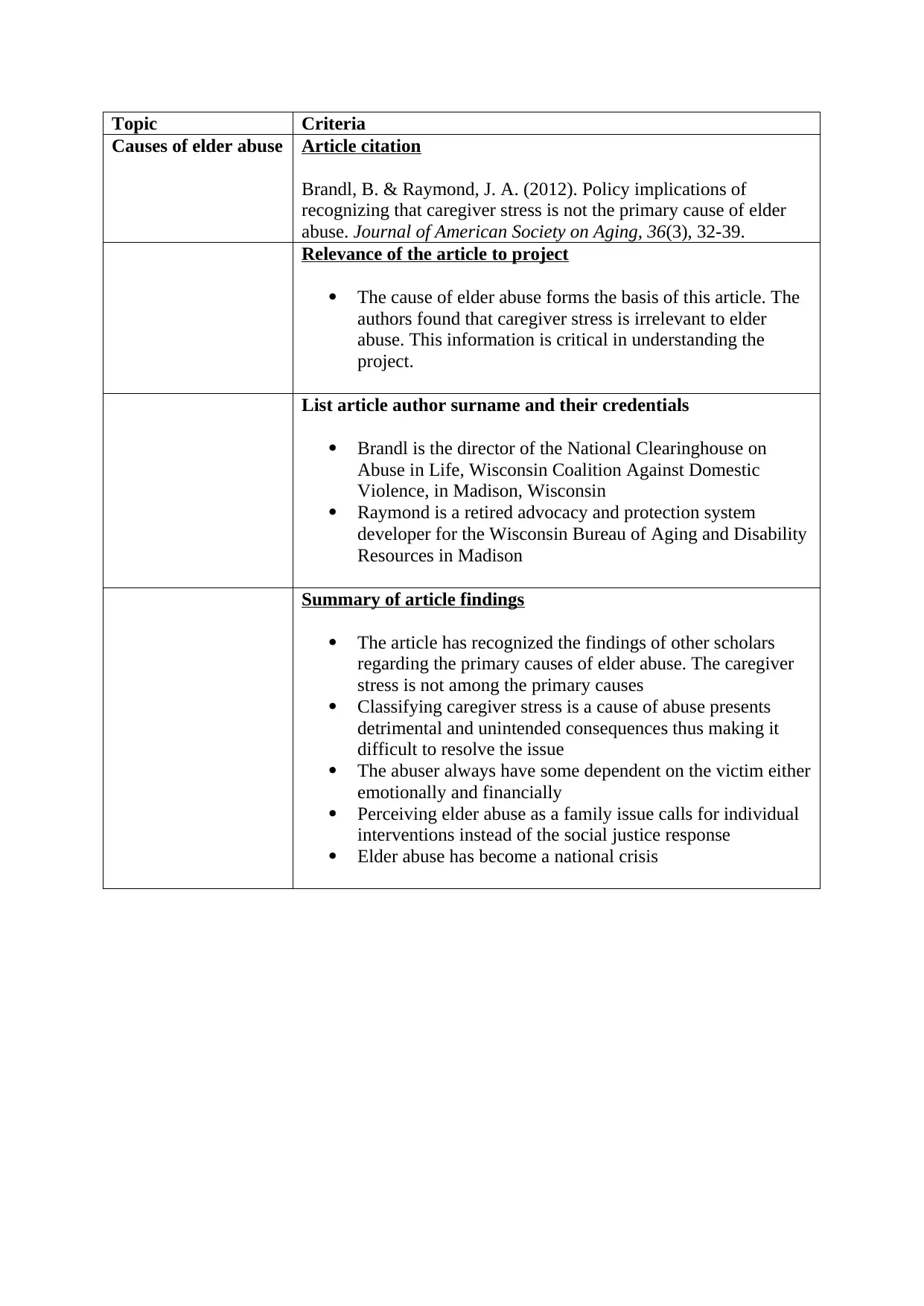
Topic Criteria
Causes of elder abuse Article citation
Brandl, B. & Raymond, J. A. (2012). Policy implications of
recognizing that caregiver stress is not the primary cause of elder
abuse. Journal of American Society on Aging, 36(3), 32-39.
Relevance of the article to project
The cause of elder abuse forms the basis of this article. The
authors found that caregiver stress is irrelevant to elder
abuse. This information is critical in understanding the
project.
List article author surname and their credentials
Brandl is the director of the National Clearinghouse on
Abuse in Life, Wisconsin Coalition Against Domestic
Violence, in Madison, Wisconsin
Raymond is a retired advocacy and protection system
developer for the Wisconsin Bureau of Aging and Disability
Resources in Madison
Summary of article findings
The article has recognized the findings of other scholars
regarding the primary causes of elder abuse. The caregiver
stress is not among the primary causes
Classifying caregiver stress is a cause of abuse presents
detrimental and unintended consequences thus making it
difficult to resolve the issue
The abuser always have some dependent on the victim either
emotionally and financially
Perceiving elder abuse as a family issue calls for individual
interventions instead of the social justice response
Elder abuse has become a national crisis
Causes of elder abuse Article citation
Brandl, B. & Raymond, J. A. (2012). Policy implications of
recognizing that caregiver stress is not the primary cause of elder
abuse. Journal of American Society on Aging, 36(3), 32-39.
Relevance of the article to project
The cause of elder abuse forms the basis of this article. The
authors found that caregiver stress is irrelevant to elder
abuse. This information is critical in understanding the
project.
List article author surname and their credentials
Brandl is the director of the National Clearinghouse on
Abuse in Life, Wisconsin Coalition Against Domestic
Violence, in Madison, Wisconsin
Raymond is a retired advocacy and protection system
developer for the Wisconsin Bureau of Aging and Disability
Resources in Madison
Summary of article findings
The article has recognized the findings of other scholars
regarding the primary causes of elder abuse. The caregiver
stress is not among the primary causes
Classifying caregiver stress is a cause of abuse presents
detrimental and unintended consequences thus making it
difficult to resolve the issue
The abuser always have some dependent on the victim either
emotionally and financially
Perceiving elder abuse as a family issue calls for individual
interventions instead of the social justice response
Elder abuse has become a national crisis
Paraphrase This Document
Need a fresh take? Get an instant paraphrase of this document with our AI Paraphraser
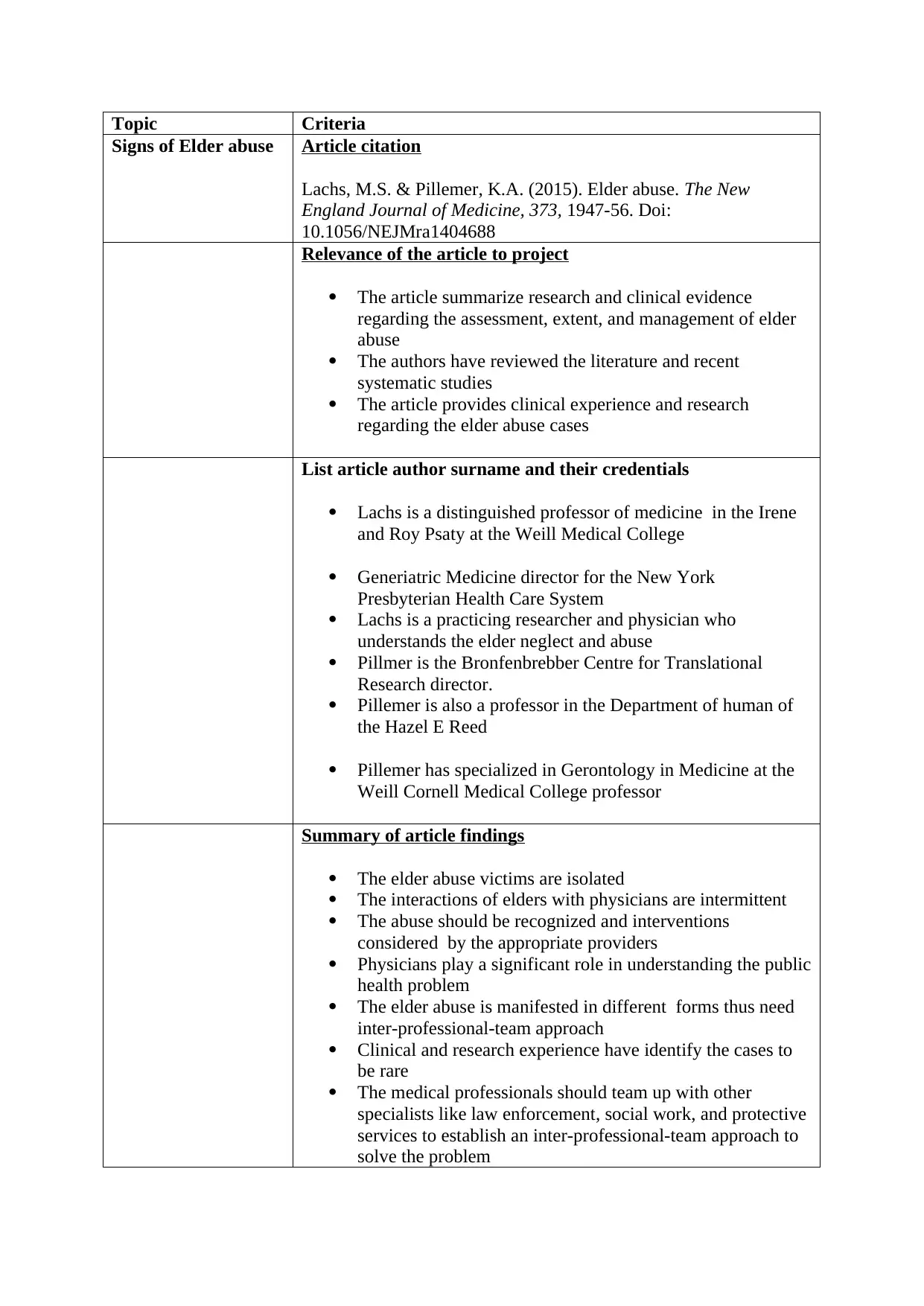
Topic Criteria
Signs of Elder abuse Article citation
Lachs, M.S. & Pillemer, K.A. (2015). Elder abuse. The New
England Journal of Medicine, 373, 1947-56. Doi:
10.1056/NEJMra1404688
Relevance of the article to project
The article summarize research and clinical evidence
regarding the assessment, extent, and management of elder
abuse
The authors have reviewed the literature and recent
systematic studies
The article provides clinical experience and research
regarding the elder abuse cases
List article author surname and their credentials
Lachs is a distinguished professor of medicine in the Irene
and Roy Psaty at the Weill Medical College
Generiatric Medicine director for the New York
Presbyterian Health Care System
Lachs is a practicing researcher and physician who
understands the elder neglect and abuse
Pillmer is the Bronfenbrebber Centre for Translational
Research director.
Pillemer is also a professor in the Department of human of
the Hazel E Reed
Pillemer has specialized in Gerontology in Medicine at the
Weill Cornell Medical College professor
Summary of article findings
The elder abuse victims are isolated
The interactions of elders with physicians are intermittent
The abuse should be recognized and interventions
considered by the appropriate providers
Physicians play a significant role in understanding the public
health problem
The elder abuse is manifested in different forms thus need
inter-professional-team approach
Clinical and research experience have identify the cases to
be rare
The medical professionals should team up with other
specialists like law enforcement, social work, and protective
services to establish an inter-professional-team approach to
solve the problem
Signs of Elder abuse Article citation
Lachs, M.S. & Pillemer, K.A. (2015). Elder abuse. The New
England Journal of Medicine, 373, 1947-56. Doi:
10.1056/NEJMra1404688
Relevance of the article to project
The article summarize research and clinical evidence
regarding the assessment, extent, and management of elder
abuse
The authors have reviewed the literature and recent
systematic studies
The article provides clinical experience and research
regarding the elder abuse cases
List article author surname and their credentials
Lachs is a distinguished professor of medicine in the Irene
and Roy Psaty at the Weill Medical College
Generiatric Medicine director for the New York
Presbyterian Health Care System
Lachs is a practicing researcher and physician who
understands the elder neglect and abuse
Pillmer is the Bronfenbrebber Centre for Translational
Research director.
Pillemer is also a professor in the Department of human of
the Hazel E Reed
Pillemer has specialized in Gerontology in Medicine at the
Weill Cornell Medical College professor
Summary of article findings
The elder abuse victims are isolated
The interactions of elders with physicians are intermittent
The abuse should be recognized and interventions
considered by the appropriate providers
Physicians play a significant role in understanding the public
health problem
The elder abuse is manifested in different forms thus need
inter-professional-team approach
Clinical and research experience have identify the cases to
be rare
The medical professionals should team up with other
specialists like law enforcement, social work, and protective
services to establish an inter-professional-team approach to
solve the problem
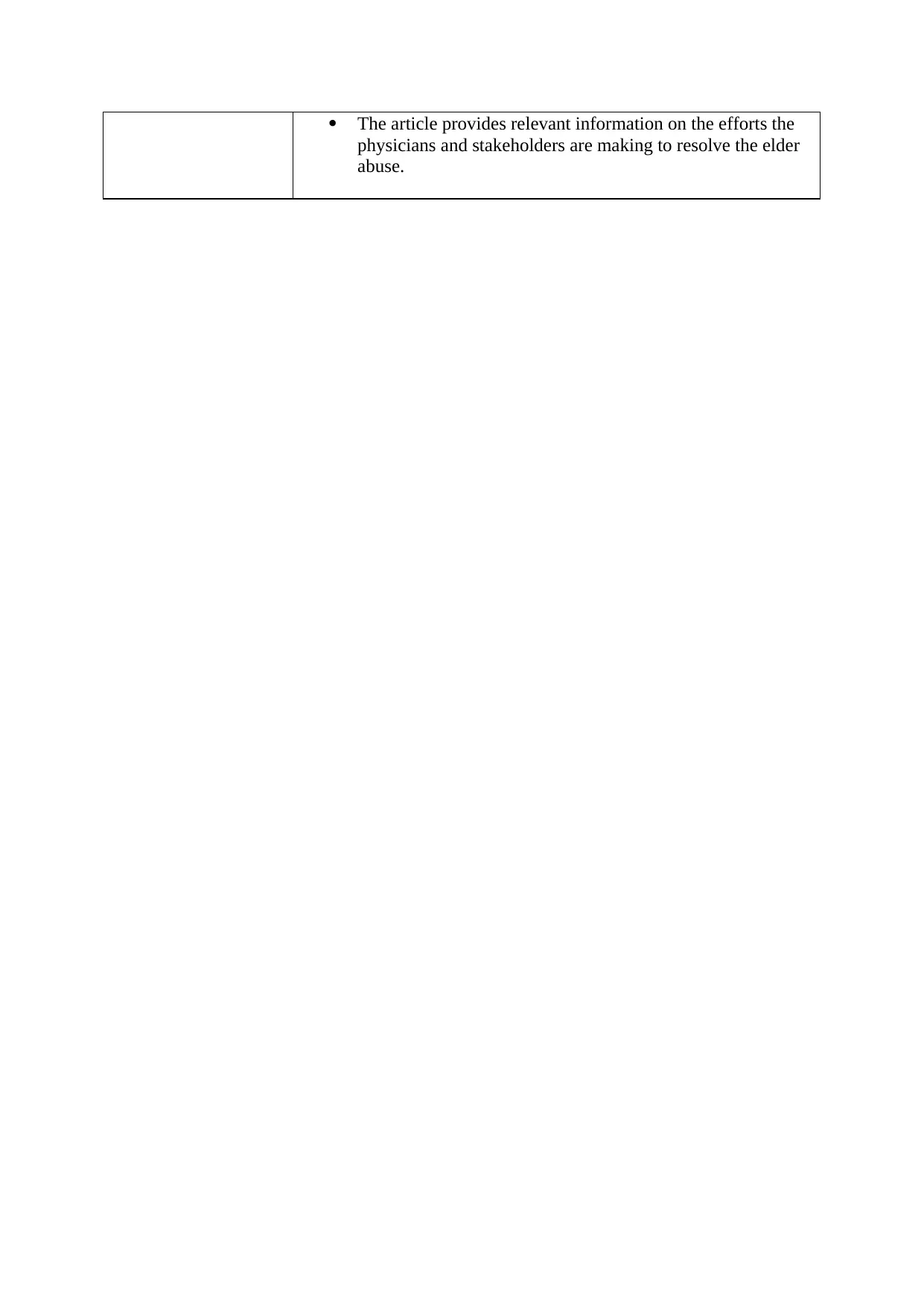
The article provides relevant information on the efforts the
physicians and stakeholders are making to resolve the elder
abuse.
physicians and stakeholders are making to resolve the elder
abuse.
⊘ This is a preview!⊘
Do you want full access?
Subscribe today to unlock all pages.

Trusted by 1+ million students worldwide
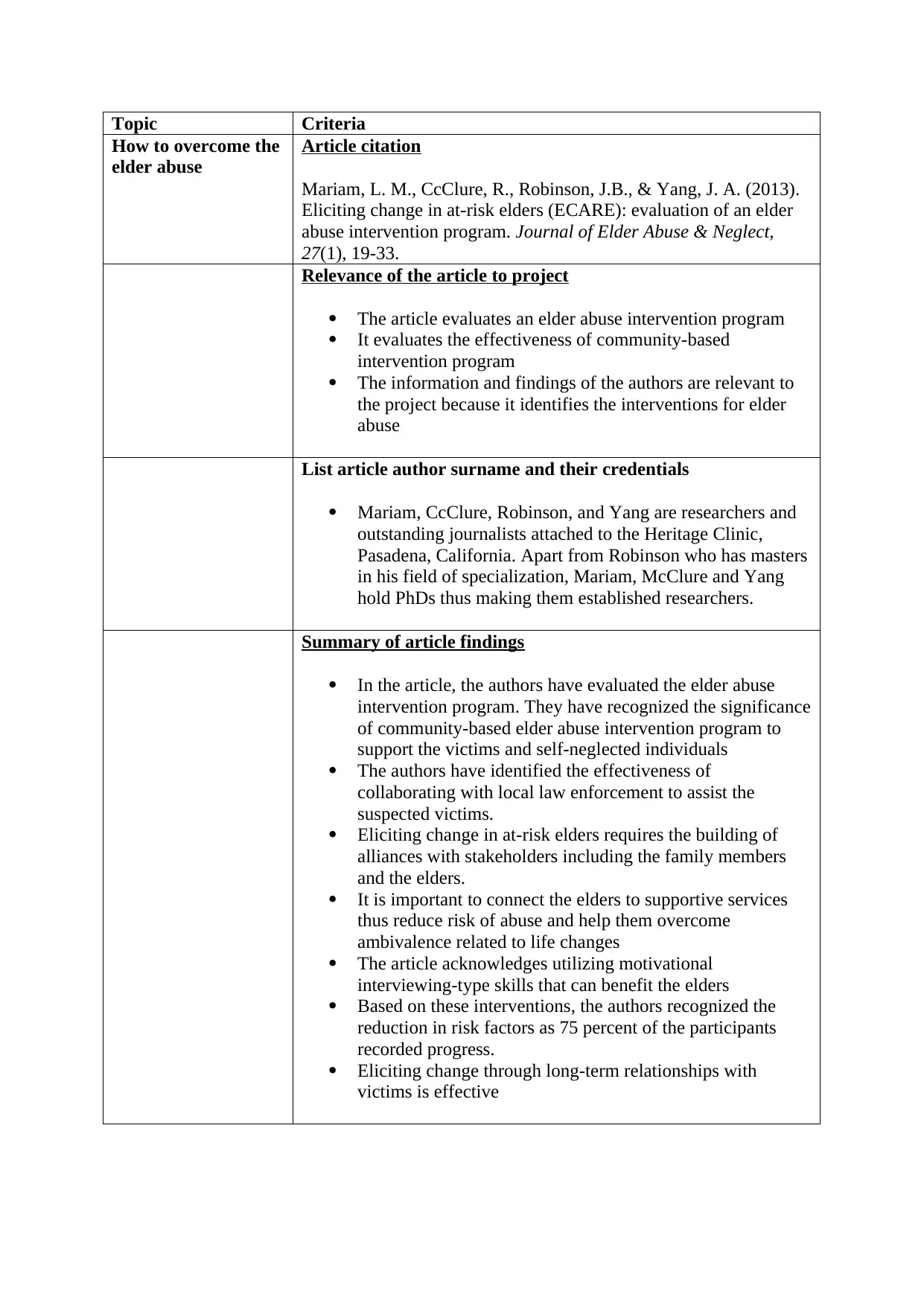
Topic Criteria
How to overcome the
elder abuse
Article citation
Mariam, L. M., CcClure, R., Robinson, J.B., & Yang, J. A. (2013).
Eliciting change in at-risk elders (ECARE): evaluation of an elder
abuse intervention program. Journal of Elder Abuse & Neglect,
27(1), 19-33.
Relevance of the article to project
The article evaluates an elder abuse intervention program
It evaluates the effectiveness of community-based
intervention program
The information and findings of the authors are relevant to
the project because it identifies the interventions for elder
abuse
List article author surname and their credentials
Mariam, CcClure, Robinson, and Yang are researchers and
outstanding journalists attached to the Heritage Clinic,
Pasadena, California. Apart from Robinson who has masters
in his field of specialization, Mariam, McClure and Yang
hold PhDs thus making them established researchers.
Summary of article findings
In the article, the authors have evaluated the elder abuse
intervention program. They have recognized the significance
of community-based elder abuse intervention program to
support the victims and self-neglected individuals
The authors have identified the effectiveness of
collaborating with local law enforcement to assist the
suspected victims.
Eliciting change in at-risk elders requires the building of
alliances with stakeholders including the family members
and the elders.
It is important to connect the elders to supportive services
thus reduce risk of abuse and help them overcome
ambivalence related to life changes
The article acknowledges utilizing motivational
interviewing-type skills that can benefit the elders
Based on these interventions, the authors recognized the
reduction in risk factors as 75 percent of the participants
recorded progress.
Eliciting change through long-term relationships with
victims is effective
How to overcome the
elder abuse
Article citation
Mariam, L. M., CcClure, R., Robinson, J.B., & Yang, J. A. (2013).
Eliciting change in at-risk elders (ECARE): evaluation of an elder
abuse intervention program. Journal of Elder Abuse & Neglect,
27(1), 19-33.
Relevance of the article to project
The article evaluates an elder abuse intervention program
It evaluates the effectiveness of community-based
intervention program
The information and findings of the authors are relevant to
the project because it identifies the interventions for elder
abuse
List article author surname and their credentials
Mariam, CcClure, Robinson, and Yang are researchers and
outstanding journalists attached to the Heritage Clinic,
Pasadena, California. Apart from Robinson who has masters
in his field of specialization, Mariam, McClure and Yang
hold PhDs thus making them established researchers.
Summary of article findings
In the article, the authors have evaluated the elder abuse
intervention program. They have recognized the significance
of community-based elder abuse intervention program to
support the victims and self-neglected individuals
The authors have identified the effectiveness of
collaborating with local law enforcement to assist the
suspected victims.
Eliciting change in at-risk elders requires the building of
alliances with stakeholders including the family members
and the elders.
It is important to connect the elders to supportive services
thus reduce risk of abuse and help them overcome
ambivalence related to life changes
The article acknowledges utilizing motivational
interviewing-type skills that can benefit the elders
Based on these interventions, the authors recognized the
reduction in risk factors as 75 percent of the participants
recorded progress.
Eliciting change through long-term relationships with
victims is effective
Paraphrase This Document
Need a fresh take? Get an instant paraphrase of this document with our AI Paraphraser

1 out of 8
Your All-in-One AI-Powered Toolkit for Academic Success.
+13062052269
info@desklib.com
Available 24*7 on WhatsApp / Email
![[object Object]](/_next/static/media/star-bottom.7253800d.svg)
Unlock your academic potential
Copyright © 2020–2025 A2Z Services. All Rights Reserved. Developed and managed by ZUCOL.